Specialist
In 1893 the National Society for the Employment of Epileptics purchased Skipping's Farm at Chalfont Common, just over 4 miles from Rickmansworth, to establish a Colony to provide care and employment for epileptic patients from all over Britain. The Society had itself been established in London two years previously by a group of doctors from the Hospital for the Paralysed and the Epileptic and philanthropists to provide such patients with an occupation, especially in the open air, so that they would be useful and able to perform practical work. At this time many epileptics were placed in workhouses or mental asylums due to difficulties in being able to earn a living because of their condition.
The 135-acre farm and its farmhouse were bought for £3,900 in November 1893. The farm tenant, Samuel Sills, remained, paying an annual rent of £1 an acre, on the agreement that he would relinquish land when the Society needed it.
The Cornish philanthropist, John Passmore Edwards (1823-1911), donated £4,000 towards the cost of the site and a further £1,000 towards the farm's expenses.
The Building Committee decided to erect two temporary iron huts on the site so that the Colony could be established as quickly as possible. The huts - one 40 ft by 36 ft (12.2 x 11 metres) and the other 40 ft by 20 ft (12.2 x 6.1 metres) - were connected by a corridor. Several smaller ancillary buildings were also added.
The first 14 Colonists arrived in July 1894, to be looked after by 5 members of staff (a female superintendent, a bailiff, a male attendant, a nurse and a female servant). Their first residence was known as The Home, Skippings Farm. It was later renamed Alpha House, but was often referred to as the Iron Home. Water was supplied through a horse-driven pump. The farm tenant, Mr Sills, initially provided milk and butter to the Colonists until their own farm was established. He was also employed to plough and till the land used by the Society (he later became the Bailiff and remained with the Society until his death in 1912).
The Colonists were charged 10 shillings (£0.50) a week , although financial help was available from an annuity fund for those who could not afford this.
Work began on the first permanent dwelling in September 1894. John Passmore Edwards offered to pay for the costs of the building, estimated at about £1,800. He laid the foundation stone of the two-storey cottage on 14th November 1894, which was also the official date of the opening of the Colony.
The Chalfont Epileptic Colony was officially opened in November 1895 by the Duke of Devonshire. It was the first institution of its kind in England. The new cottage had already been occupied by half the residents from the Iron Home in August 1895. Built in local brick up to the first floor and then roughcast above, the cottage could accommodate 18 male Colonists in two dormitories, a Matron and other staff. It was named Passmore Edwards House.
In 1896 work began on the second building, a cottage for women. Passmore Edwards again provided the necessary funds, some £2,861. Sited near the main gate, well away from the men's dwellings, the cottage could accommodate 24 Colonists. It was named Eleanor House, after Mrs Passmore Edwards, and was officially opened by Mrs Bayard in 1897. The cottage was built in red brick with red roof tiles and half-timbered oak gables. Its large hall was decorated with a frieze of poppies, painted by the Kyrle Society.
A Recreation Hall was built in 1896. A Mrs Cash had offered £200 to the Society to provide a small hall, on condition that it be built within six months. The Hall, built of corrugated iron on metal frames, cost £182 and could seat 100 people. Mrs Cash opened the Hall herself in December 1896. (It remained in use for shows, lectures and church services until 1958.)
Passmore Edwards had offered to provide funds for another house for male colonists in 1896 and work began on this early in 1897, the year of Queen Victoria's Diamond Jubilee. The 2-storey red brick cottage was named Victoria House in honour of the occasion, and was completed in the spring of 1898 at a cost of £2,788. The ground floor could accommodate 24 colonists. Staff quarters were on the floor above. The cottage was occupied by the remainder of the residents of the iron huts (Alpha House) in the late summer of 1898, together with some new arrivals.
Dearmer House was also added to the site in 1897, the gift of Mrs Caroline Dearmer, whose son had died of epilepsy at the age of 18. Built at a cost of £1,182, the single-storey building was intended for those needing special care and treatment.
Passmore Edwards was keen to provide similar facilities for epileptic children, and two cottages were planned. Each cottage would have two 12-bedded dormitories, a kitchen and dining room, a play room and a sick room. In addition, there would be three staff bedrooms. and sitting rooms for the House Mother and the nurse and also, in the girls' Home, a bedroom for two servants.
The two cottages - Milton House, for boys, and Pearman House, for girls - were completed in 1899, but remained empty. The Elementary Education (Defective and Epileptic Children) Act, 1899, prevented children's homes from boarding more than 15 children in one building. The Society decided that the new homes should be allocated to older children and young adults aged from 14 (boys) and 15 (girls).
The two houses were officially opened in June 1899 by the Duke of York, the President of the Society. Milton House had been extended with an iron hut containing 8 beds, and could house 24 young men. Pearman House accommodated 20 women and girls. (The '15' clause in the Act was not removed until 1903, and it was not until 1909 that younger children were admitted to the Colony.)
In July 1899 Greene House opened. It had been mainly financed by a wealthy businessman from Surrey, Frederick Greene, who had donated £2,000 in July 1896 to the Society towards the building costs. The House had cost £2,348 and could accommodate 24 men. The colonists living in Passmore Edwards House were transferred to the new building, while Passmore Edwards House became a home for boys aged 15 years and over.
Epileptics were, for the first time, about to cultivate a life of their own among people of their own age, rather than being cut off from society. The Colony by now had a large farm - some 370 acres - which was one of the main features of the establishment. The men lived in healthy conditions with skilled care at hand, and were employed in various kinds of outdoor work - farming, gardening, fruit cultivation, etc. Many were also employed in utility workshops, providing goods and services for the Colony - carpentry, tailoring, shoe-making, basket-making, smithing, etc. The women worked in the laundry, the kitchen or in the needle room, where they made their own clothes and mended all garments for the Colony. Bed linen and mattresses were also made and repaired. Both sexes undertook domestic duties. In their free time, sport was encouraged and cricket was particularly popular.
In 1899 Passmore Edwards offered £2,500 to pay for a new larger administration building, which had become necessary as the Colony had grown. Its foundation stone was laid in 1903 by Sir William Broadbent. Nevertheless, building costs had risen dramatically at the turn of the century and Passmore Edwards increased his donation to £3,000. However, the estimated cost of the building had risen to nearly £4,800, so the plans were amended, with the intention that extensions could be added later.
By the end of June 1900 the epileptic population was 110 with a staff of 14 persons.
On 31st December 1903, there were 114 male and 57 female colonists. Of these, 8 were aged between 13 and 16 years, 42 between 16-20, 71 between 20-30, 35 between 30-40, 14 between 40-60, and one over 60 years of age. Since its opening, 241 had left the Colony and 3 had died.
On 20th October 1904 the new administration building was officially opened by Lord and Lady Rothschild. It was named Passmore Edwards House, and the former Passmore Edwards House was renamed Susan Edwards House, in honour of Passmore Edwards' mother. The ground floor of the new building contained a kitchen, a dispensary, offices for Matron and her Assistant, and Matron's sitting room. On the first floor was sleeping accommodation for Matron and the nursing staff. Most of the building work had been undertaken by the Colonists.
Hampshire House, with 24 beds for female epileptics, had opened earlier in 1904. The cost of the building and its furnishings and equipment - an estimated £4,000 - had been paid for in 1902 by an anonymous donor (later revealed to be Mr John Martineau) on the understanding that priority would be given to epileptics from Hampshire. Arrangements were made with the local authorities in Southampton to maintain these patients.
By the early 20th century the Colony consisted of eight red brick villas, resembling a little village. The villas were separated from each other by a considerable distance and were surrounded by fields. There were 135 colonists, mainly men. The cost of the buildings had, for the greater part, been borne by Mr Passmore Edwards, who had donated £83,000 of the £84,800 required. In recognition of his generosity, he was made a Vice-President of the Society.
In 1907 the National Society for the Employment of Epileptics was renamed the National Society for Epileptics. In 1909 there were plans to build another two houses to accommodate 24 children in each, as a consequence of a change in legislation.
In 1912 Passmore Edwards House was extended and, in March 1913, the Society mortgaged the farm to finance the building of a new home for 30 women. Work began on the building just before the outbreak of WW1 in August 1914. The building was completed at a cost of £3,295 in the following spring. It was named Penn House, in honour of Mr George Penn-Gaskell, the first full-time Secretary to the Society, and William Penn, the founder of Pennsylvania, who is buried in the nearby village of Jordans.
In 1923 a Committee Room was added to Passmore Edwards House. The Colony at this time resembled an attractive modern village, with each house in its own grounds and a path leading through a well-tended garden to the front door. The more modern buildings were single-storey. Their interiors were homely, with one end of the building given over to the dining and general rooms, which were partitioned and could be opened up into one large room. The other end of the building contained two large dormitories. In the central part of the house were the kitchen, pantry, bathroom and wash rooms, the linen cupboard, the Sister's and attendant's rooms, and one room which could be used as an isolation ward. Between the dormitores was a small bedroom where the attendant slept; at night the lights in the dormitories were dimmed, as the patients were never left in the dark.
Kitchener House and Stanley Maude were added to the north of Dearmer House during the 1920s.
By 1935 the Colony had some 358 acres of land. Many of the male Colonists were employed on the farm under the direction of the farm bailiff, as well as in the well-kept orchard. All the repairs to the buildings and much of their furnishing was done by the men themselves. The women and children occupied one end of the estate, where the school buildings were located. The laundry with its sorting room, the main kitchen and storerooms were grouped around Passmore Edwards House. The Colony had 510 epileptics resident in its 18 homes. The weekly maintenance cost of each Colonist was £1 1s (£1.05), paid variously by relatives, county or district grants, or by the 'Maintenance Fund' of the Society. Convalescent patients, discharged from hospital, were received at a charge of £1 5s (£1.25) a week.
A period of two years free from fits was usually considered to indicate a cure.
After the working day, sports and hobbies were encouraged. A hut had been built for Scout, Guide and Cub activities.
Meals were prepared in the main kitchen and then sent round to each dwelling. Cooking was done by gas, but there was a coal range in case the gas supply failed. The store cupboards were stocked with bottled fruits and jams made from produce from the gardens and orchards.
Although the Colony did not admit children under the age of 6, because of their interrupted schooling many of the children were behind the standard for their age, and many over the age of 11 were still learning the most elementary subjects. The School has four classrooms, in each of which the children were divided into two groups. One group followed the ordinary school curriculum, while the others did handwork - art or needlework - as too close study tended to induce fits in these children.
In 1948 the Colony was disclaimed by the NHS and remained an independent charitable organisation.
By the 1950s over 550 epileptics lived at the Colony. In 1953 an arrangement was made with the National Hospital for Nervous Diseases for patients to attend there for investigation and assessment either before, or shortly after, admission to the Colony. It was hoped that a percentage of the patients could be treated there and returned to normal life within a matter of weeks.
Because of the falling numbers of children, the school closed in 1957. The remaining pupils were transferred to the Lingfield Epileptic Colony (now known as the National Centre for Young People, run by the charity Young Epilepsy).
During the 1960s the Colony changed its name to the Chalfont Centre for Epilepsy. The buildings were refurbished and modernised.
Several new anti-epileptic drugs became available, enabling seizures to be better controlled in the majority of newly diagnosed children and adults. The first resident doctors were appointed to the Centre.
By the late 1960s patients began to be admitted for short-term care. A therapeutic work centre was established and a warden-supervised hostel, with bed-sitting rooms, was opened in a new building, Lakeman House.
A Special Assessment Unit opened in 1972, especially for patients with severe and complicated epilepsy. It was run jointly by the National Hospital and the National Society for Epileptics (it is the origin of the purpose-built Sir William Gowers Assessment Unit - the current NHS facility on the site, named after one of the Society's founding neurologists). Most patients stayed for three to six months. If they needed longer care, they were admitted to the main site.
In the 1970s the Society changed its name once more, to the National Society for Epilepsy. By 1974 more than 400 epileptics were living permanently at the Centre.
In the 1980s Paget House (later renamed Queen Elizabeth House), a modern, purpose-built nursing home with 20 beds, opened.
In 1995 a 1.5 Tesla MRI scanner was installed by the Society - the first dedicated to research in epilepsy - so that patients could be examined and assessed. It was replaced in 2004 by a 3 Tesla scanner, which produces higher resolution images.
Present status (August 2009)
Today the Chalfont Centre is one of the leading centres of excellence for the diagnosis and treatment of epilepsy, encouraging those with the condition to lead independent lives as far as possible.
Passmore Edwards House, Pearman House, Milton House and Greene House are Grade II listed buildings. In 2009 it was proposed to demolish several of the original and later villas, including Dearmer House, and replace them with modern care facilities.
Update: October 2012
In 2011 the National Society for Epilepsy became the Epilepsy Society.
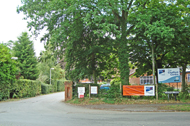
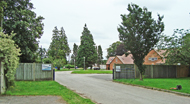
The main entrance to the Centre off Chesham Lane (left). The entrance to the Centre (right).
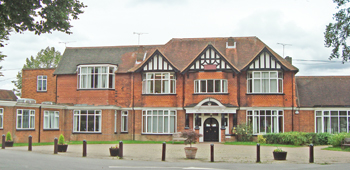
Passmore Edwards House on Micholls Avenue, the Grade II listed administration building built in 1904 (above and below).
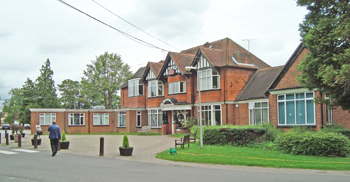
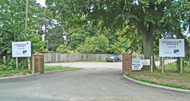
Debenham Gate.
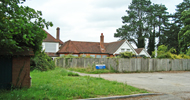

Debenham House, an NHS facility once run by Buckinghamshire Mental Health, closed in 2005 and is now boarded-up.
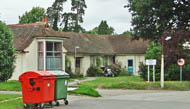
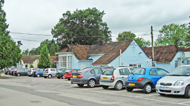
One-storey buildings on the site (above and below).
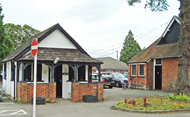

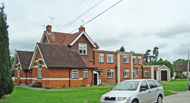
A 2-storey villa with multiple extensions.
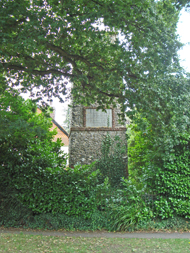
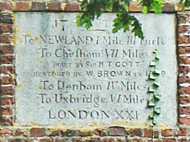
A milestone pillar by the main entrance, indicating London to be 21 miles away.
At first this involved the artistic decoration of schools, hospitals and workmen's clubs, and many branches formed around the country, including one supported by William Morris.
The Open Space Committee of the Society managed to save many areas of heathland and woodland in London, which otherwise would have been used for housing. Members of the Society also planted trees and flowers in urban areas.
One of the Society's branches - the Invalid Children's Aid Association - became independent in 1908.
The Society no longer exists.
(Author unstated) 1895 The epileptic colony at Chalfont. The Lancet 145 (3725), 169.
(Author unstated) 1895 Reflections from a Board Room Mirror. Nursing Record and Hospital World, 22nd June, 444.
(Author unstated) 1896 The epileptic colony at Chalfont: laying the foundation stone of a home for women. The Lancet 147 (3796), 1507.
(Author unstated) 1897 Reflections from a Board Room Mirror. Nursing Record and Hospital World, 22nd May, 420.
(Author unstated) 1902 Reflections from a Board Room Mirror. Nursing Record and Hospital World, 21st June, 501.
(Author unstated) 1902 The treatment of epilepsy. British Journal of Nursing, 9th August, 108.
(Author unstated) 1903 Reflections from a Board Room Mirror. British Journal of Nursing, 1st August, 95.
(Author unstated) 1904 The care of the epileptic and feeble-minded. British Medical Journal 2 (2270), 23-24.
(Author unstated) 1904 National Society for Employment of Epileptics. British Medical Journal 2 (2287), 1181.
(Author unstated) 1904 The employment of epileptics. British Journal of Nursing, 29th October, 346.
(Author unstated) 1921 Reports by the Joint War Committee and the Joint War Finance Committee of the British Red Cross Society and the Order of St John of Jerusalem in England on Voluntary Aid Rendered to the Sick and Wounded at Home and Abroad and to British Prisoners of War, 1914-1919. London, HMSO (reprinted in facsimile, 2009. The Naval and Military Press Ltd in association with the Imperial War Museum), pp 249-253.
(Author unstated) 1974 Chalfont Epilepsy Centre. British Medical Journal 4 (5939), 295.
Haward FC 1949 The use of "Tridone" in petit mal. British Medical Journal 2 (6th August), 315-316.
Hutton IM 1935 A visit to the Chalfont Colony of the National Society for Epielptics. British Journal of Nursing (May), 120-121.
Rutherford S 1999 A therapeutic Bucks landscape. The Bucks Gardener 6, 7-9.
Sander JWAS, Barclay J, Shorvon SD 1993 The neurological founding fathers of the National Society for Epilepsy and of the Chalfont Centre for Epilepsy. Journal of Neurology, Neurosurgery and Psychiatry 56, 599-604.
Turner WA 1900 A discussion on the treatment of epileptics in colonies. British Medical Journal 2 (2073), 809-810.
http://hansard.millbanksystems.com
http://list.english-heritage.org.uk
http://passmoreedwards.org.uk
www.british-history.ac.uk
www.britishlistedbuildings.co.uk (1)
www.britishlistedbuildings.co.uk (2)
www.buckinghamshireadvertiser.co.uk
www.buckscc.gov.uk
www.chalfontstpeter-pc.gov.uk
www.epilepsysociety.org.uk
www.erg.ion.ucl.ac.uk
www.geograph.org.uk (1)
www.geograph.org.uk (2)
www.mybuckinghamshire.co.uk
www.pastscape.org.uk
www.zen16514.zen.co.uk
Return to home page